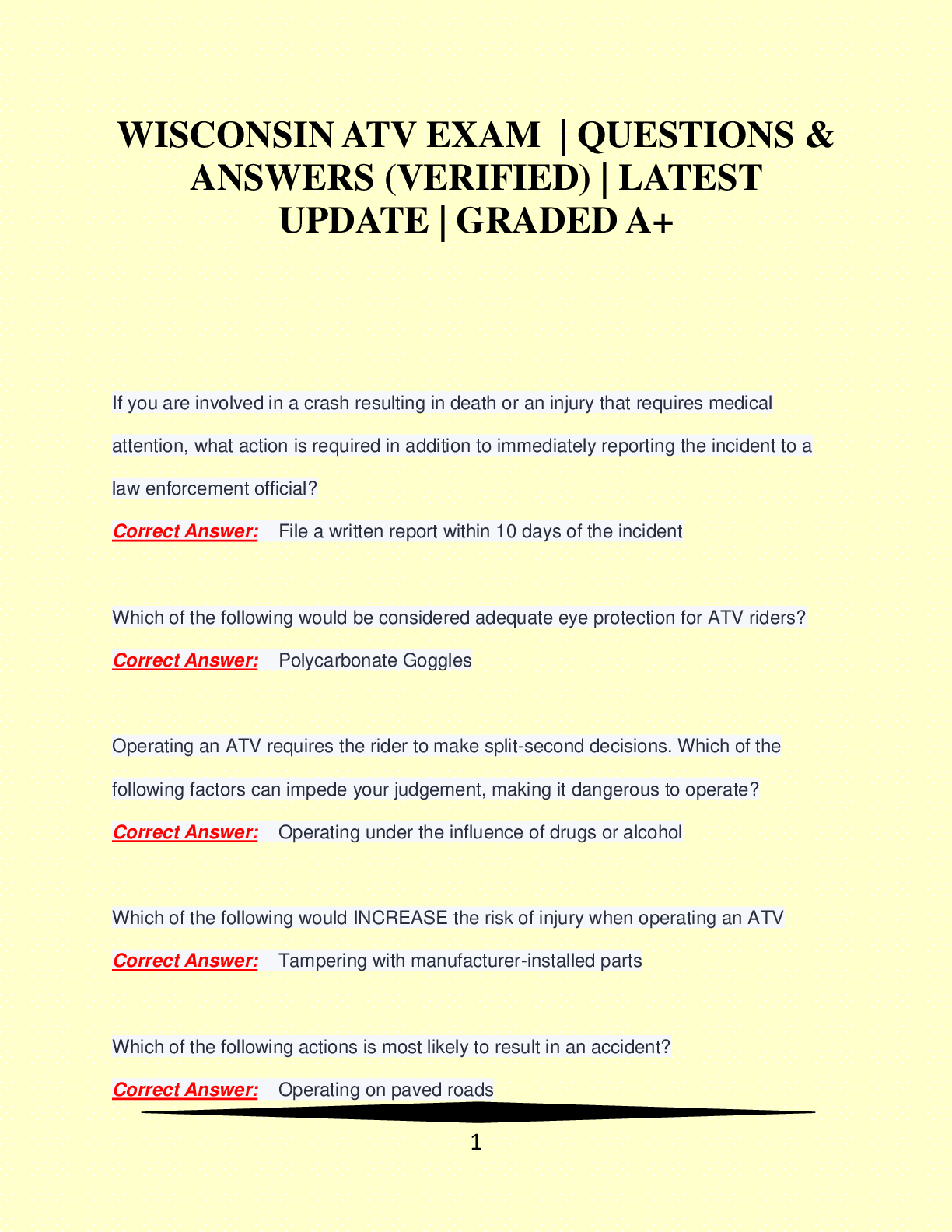
WISCONSIN CITIZENSHIP EXAM QUESTIONS & ANSWERS VERIFIED LATEST UPDATE
Surgery > QUESTIONS & ANSWERS > Surgery Week Quiz Series - Part 7 [GRADED A+] (All)
Surgery week 7 quiz # 1 of - 1 Points USMLE Step 2 CK Board Preparation 1. A 7-year-old boy presents with headaches, nausea, and lethargy. According to his parents, the boy has been consuming larg ... e amounts of fluids. He also urinates frequently. A previously healthy child, he has no significant past medical history. His symptoms began approximately 3 weeks ago. His parents thought that it was his increased activity level that led to his increased fluid intake. However, over the past few days, he has been becoming more lethargic and is still consuming large amounts of water and juice. On physical exam, the boy appears to be thin, ill-appearing, and lethargic. His eyes appear sunken and his skin is dry. His vital signs are as follows: blood pressure 100/54 mm Hg, temperature 99.0 degrees Fahrenheit, pulse 120 beats per minute, and a respiratory rate of 22 per minute. Laboratory tests show dilute urine with a specific gravity of 1.002 and a urine osmolality of 199 mOsm/kg. His plasma osmolality is 296 mOsm/kg. What statement is true? A. The genetic form of diabetes insipidus is rare and is usually in an autosomal recessive pattern B. The drug of choice for treatment is chlorpropamide C. Idiopathic DI is associated with destruction of cells in the hypothalamus, often as part of an autoimmune process D. Patients with nephrogenic DI have low serum ADH levels E. An individual with DI cannot normally drink enough fluid to keep up with fluid loss 2. A 5-year-old girl presents with a 2-month history of a gradually increasing swelling in the neck. The child is otherwise asymptomatic. There is a similar complaint in most neighboring children. Cauliflower is the main crop in the region. She has no other developmental problems. On physical exam, her thyroid gland is non-tender, soft, and symmetrically enlarged without any palpable nodules or signs of compression. The thyroid function test showed slightly low thyroxine (T4) and normal TSH and triiodothyronine (T3) levels. Her urinary iodine level was also low. What is the most likely diagnosis? A. Toxic nodular goiter B. Graves' disease C. Diffuse non-toxic goiter D. De Quervain thyroiditis E. Multinodular goiter 3. A 17-year-old girl presents with bleeding from the nose and the gums. She has previously had similar bleeding episodes. She also gives a 4-day history of right knee pain. Her parents are healthy, and there is no history of bleeding disorders. Physical examination revealed a tender swelling of the right knee joint, malar rash, and oral ulcers. Coagulation profiles showed normal platelet count and prothrombin time, prolonged bleeding time and markedly prolonged activated partial thromboplastin time (aPTT). Coagulation factor assay revealed marked deficiency of factor-VIII, and von Willebrand factor (VWF) level assayed for ristocetin cofactor activity, was also diminished. What is an acquired cause of this patient's condition? A. Systemic lupus erythematosus B. Hyperthyroidism C. Fibroadenoma D. Tuberculosis E. Emphysema 4. A 58-year-old man has had blood pressure readings ranging from 145/90 mm Hg to 180/110 mm Hg on multiple occasions over the last 2 months. On physical exam, he is calm and nondiaphoretic. Auscultation reveals rhythmic S1 and S2 without apparent pulse deficit or rales bilaterally. Neurological examination is negative. Reflexes bilaterally are 2+. Resting ECG is negative for abnormal T-waves or S-T deviations. Patient's fasting blood glucose level is 145 mg/dL and 150 mg/dL on 2 separate occasions. What is the most appropriate medical management in this patient? A. Initiate metoprolol and titrate to achieve adequate BP levels B. Initiate lisinopril and pioglitazone C. Initiate hydrochlorothiazide and pioglitazone D. Initiate treatment with furosemide E. Initiate metformin and lisinopril 5. A 20-year-old Caucasian American female with a 17-year history of insulin dependent diabetes has a yearly urinalysis. She has no other medical problems and no known diabetic complications. Her blood pressure and the remainder of her physical exam are normal. Her urinalysis shows: 100 mg albumin/g creatinine No cells No crystals No blood No casts No leukocyte esterase, nitrate or bacterial growth What is her diagnosis? A. Nephrotic syndrome B. Nephritic syndrome C. Microalbuminuria D. Macroalbuminuria E. Orthostatic proteinuria [Show More]
Last updated: 2 years ago
Preview 1 out of 23 pages
![Preview image of Surgery Week Quiz Series - Part 7 [GRADED A+] document](https://browseimages.nyc3.digitaloceanspaces.com/paper-images/2023/May/08/z7Ex5ao22023-05-08-03-346458ec5d76cce.png)
Buy this document to get the full access instantly
Instant Download Access after purchase
Buy NowInstant download
We Accept:


Surgery week 10 quiz Q # 1 of 39- 1 Points USMLE Step 2 CK Board Preparation 1. A sexually active woman with multiple partners presents with a 2-day history of red swollen left knee. On examinatio...
By geeks4geeks 2 years ago
$35
10
Can't find what you want? Try our AI powered Search
Connected school, study & course
About the document
Uploaded On
May 08, 2023
Number of pages
23
Written in
All
This document has been written for:
Uploaded
May 08, 2023
Downloads
0
Views
114
Scholarfriends.com Online Platform by Browsegrades Inc. 651N South Broad St, Middletown DE. United States.
We're available through e-mail, Twitter, Facebook, and live chat.
FAQ
Questions? Leave a message!
Copyright © Scholarfriends · High quality services·